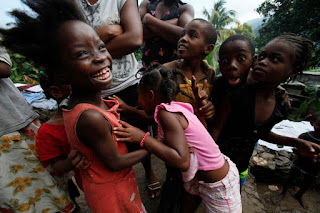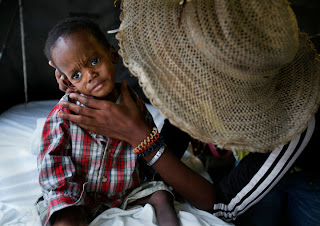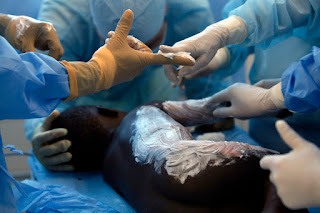A turbo prop Saab 340 dropped into a patchwork of irregular green squares leading up to impossible mountains peaks. From out of the clouds we were delivered to the stifling humidity of Cap Haitien airport, a small building divided down the middle for the coming and going.
Slow moving mounds of unspeakable waste bobbed down the stream in an open trench on its way from somewhere to somewhere else, paralleling the crowded main road. On the outskirts of a diesel landscape, paved lanes gave way to dirt where funding ran out, and suddenly we were dodging burros and goats on approach to Milot, our hospital compound home for the coming week.
We danced together with mosquito netting until our dorm was sufficiently chaste.
The tap water is diseased, the Coke too syrupy, but the beer is good; the town a blend of tropical Caribbean colors and decayed French colonial domination.
Hopital Sacre Coeur is a maze of concrete hallways, shabby plastic mattresses that can be hosed off, and loose wires hanging. Armed guards protect the compound from aggressive vendors selling fried incarnations of bananas or house pets. Random used latex gloves commingle in corners beside carcasses of weeks-old meals.
We are introduced to a solemn but happy NICU unit with infants and mothers seeking a miracle, as two men carry a stretcher through the yard bearing a body wrapped in a bloody cloth.
Neither the driving rain on the tin roof, nor the anxiety over the next day’s mission kept the nursing students from a sound sleep. Such was the strategic scheduling of the day’s expedition: hiking to La Citadelle, a five-mile slog up cobblestone streets, into a beguiling mist some 3,000-feet above the town. These people living along the side of the mountain with no water or sanitation, watching us pass, would be our patients.
Morning rain flooded the cholera tent. Patients pushed their IVs and waste buckets to the patio shelter. Inside the neighboring canvas army tent, students Stacey Price, RN, and Amanda O’Keefe were trying to find a vein in a severely dehydrated young girl while a man my age gasped for breath through an oxygen tube on the next bed, and an immaculately dressed young woman with an innocent smile sat patiently in a wheelchair, leaning over her swollen leg, deformed by filiariasis, the open sores dripping onto the floor.
Relatives propped their shoulders against the opening of the heavy canvas tent, sometimes collecting a bed pan from their loved one, emptying its contents into the banana leaves just outside the tent. When the woman with heart failure and a swollen belly and legs from the anemia was moved to the hospital and her urine-soaked sheet stripped from the bed, it was the last sheet. 10:30 a.m.
No amputation for the man with gangrene today. Maybe tomorrow. Nurses took turns holding the month-old preemie abandoned by its mother. Two students instructed new mothers in proper breast-feeding: the 17-year-old with twins sat on the floor and draped her upper body across the bed. The other, in a pale pink silk nightie, stared straight ahead as her two-day old wailed behind her. Racked with pain from her C-section she had assumed she had no milk to give him. Propping the baby on a pillow below her breasts, her son made up for meals missed. That evening, before dinner, we watched a C-section in an immaculate operating room, performed by a well-equipped team of Haitian doctors and nurses moving in seemless waltz to deliver an 8-pound baby boy named Carwyn.
It was not the rain on the roof but the voodoo drums that kept us awake past midnight.These are nurses: before filing over to a breakfast of local grapefruit and French toast (go figure), all beds were neatly made, with mosquito netting taut at the corners. Discussing the despair over the lack of basic medical supplies, a handful of students proposed coming back to run a black market in masks, gloves, gauze and Tylenol.
They are ready for the real world.
My new best friends are the surgeon from Guinea Bissau who came to assist Haiti after the earthquake, and stayed on. He speaks perfect Spanish. And the female doctor from Cuba. Then there's the medical stenographer from Calgary.
Milot is a vortex for the medically gifted, wanting to help. But no one is immune. The radiology team from Boston is down for the count.
It is a medical question here when one asks whether you are (able to) eat rice and beans for lunch.
Motionless children in their Sunday dresses try to smile through exhausted dark eyes lying prone in their cholera beds: a wooden plank with a hole cut in the middle; a plastic bucket strategically positioned underneath.
The ladies seated
beside the tightly-spaced beds on the second floor are knowing me now, from the
day before, when I was kind, wordlessly acknowledging their efforts
to care for a loved one in the hopeless ward. Today
they welcomed me where they were cooking and washing, because
I am a woman, and women are collaboratively nurturing. It
was non-verbal; universal, sweet.
But some women can be
negligent. My African doctor pulled no punches berating the mother of a
2-year-old with malnourished, sunken eyes and the largest stomach tumor
he'd ever seen. The child looked 80-years-old. He had shown signs of a tumor in
November, yet she is only now seeking help. He said he hadn't seen
anything like this since Africa. The ignorance of some parents, he said, is
killing defenseless children.
The security guard has the rum. $12 for
the three star, $14 for the five star. We're all laughing under the full moon, to forget some of what we've seen. But as I turned off the light, peeling back the curtain
onto the courtyard, I watched our doctors holding down one of the compound
dogs, putting an end to his wicked ways. In the morning I wrote:
They killed the dogs last night.
Around midnight.
They caught Quattro on the porch, weaving through the knees
At the poker table,
seeking a morsel or a scratch behind the ears.
They did it in the courtyard outside the kitchen door
these doctors in
scrubs
With their needles, arms crossed, sure their methods were
sound.
Nurses and students came to their doors, some walked circles
crying
Around the pack of doctors preying on the compound mascot
As he wailed a primordial plea for mortality.
BigLove and MamaTits they caught down the road.
But we still heard it. Doors slammed, muffled tears and quick
conversations
Floated over the walls and wafted towards the waning moon.
They’d killed chickens. Attacked a Haitian pediatric nurse
walking alone.
The conversation was short.
If the Haitians think we value the dogs more than we value
them, what’s to be done?
Sister Anne said the big black one was clever. They had to
entice it with food.
It was hard on everyone in the end, she said in her lyrical
Irish way, very hard.
It’s what she said yesterday morning
Bringing food to a skeletal woman in the wound care ward
whose family had
abandoned her.
In the morning before dawn
I stepped cautiously across the killing floor to fill my
water bottle
On the porch where a
stethoscope hung from the iron window grate.
Jason Malig forgot how small the beds are. He’d rolled over
in his sleep and woke to find himself suspended in air, arms outstretched,
caught like a fly in his mosquito net. The streets were quieter this day, the second anniversary of
the earthquake that brought hundreds of wounded and volunteer doctors to this
rural town of 25,000 souls. All that remains are the six long canvas army tents
that still serve as spill over clinics and a mural. The only marking of the
memory is a four day weekend for schools and the hospital clinic.
The cholera epidemic was
imported by visiting U.N. peacekeepers from Nepal carrying a Bangladeshi strain
of the disease in October 2010. Haitians are now wary of all U.N. workers, who
travel in white jeeps, dressed in fatigues carrying weapons.
In the women’s wound care ward, Sister Anne brought juice,
fruit and bread to the emaciated young woman with necrotizing fasciitis, a
fungus that is eating away at the remaining skin on her stomach and thighs.
Dr. Sisse was draining a massive leg infection into a bucket,
cutting gangrene from a woman’s big toe, taking vital signs from a woman with
breast cancer so severe it had consumed her nipple from the inside out.
Haitians often seek care from a local herb or voodoo doctor
before coming to the hospital. One voodoo doctor poured oil over a woman’s
belly during a troubled labor, then set her on fire to release the demons. The
baby was saved but the mother could not hold him for eight months. A man died
from a root doctor’s treatment for hiccups. By the time doctors at Hopital
Sacre Coeur see people, it might be too late to do more than amputate a dead
limb or simply house the patient till they die.
We were all summoned to the hospital. A distraught father was
wringing his hands over his son, badly burned Madelin Innocent, 4. Thin gauze
covered his little body, he was in shock.
A pot of boiling water fell
on him the night before, but the tap-taps (truck taxis) had stopped running, so
the family had to wait until morning to bring him in. The boy’s clothing had
fused into his skin in places.
In a triage of international languages, the team administered
a vile of valuable morphine, and Malig, the former combat medic, hummed softly
to the boy as Dr. Sisse, three students, two nurses set to work scrubbing and
debriding the burned skin, then anointed the wound with Silvadene cream, a
topical treatment no longer used in the U.S.
That evening Yniole
Charles, 39, gave birth to her third child. An eight-pound girl entered the
world with barely a moan from her mother. She was caught by veteran Haitian
nurse Tanya Paul and two students. The baby’s father was anxiously waiting
in the maternity ward and proudly shook everyone’s hand when he saw his wife
and daughter gingerly tucked into bed.
“Bet you never thought you’d be off-roading in an ambulance,” someone
said as the entire group bounced along the rutted road to the village of
Thibeaut. A hospital outreach worker with a megaphone alerted the community on
Wednesday that a medical team would be at the church on Friday. And there they
were: 80 faces from knee high to stooped over, dressed in their very best,
singing a hymn in Creole by way of welcome.
All of us wanted to meet Jean Lomsina, 102. She had never seen
a doctor and walked to the church with her cousin, Cleanyanta Lendor, a
sprightly 89. “She’s obviously doing something right,” said student Derrick
Duarte. “Her blood pressure is better than mine.”
The team had only a few daylight hours left that afternoon to barter on
the street and poke their heads into the cemetery where the gate was finally
unlocked. A groundskeeper, if one can say the grounds are kept, reached into
one of the caskets dug up and deposited above ground for lack of payment, and
pulled out the skull, hair and all. Goats pranced and did what goats do best
among the once stately grave markers.
One of the vendors handed us a book that translated English
into French and Creole. Lesson 13 was titled: “Jean is looking for work. Today
is not Jean’s lucky day.” Fortunately, Jean got lucky in lesson 14. The average
annual income in Haiti is $400.
Just as we returned to the compound gates, a funeral passed
solemnly by, towards the cemetery.
That night and throughout
the next day's 17 hours of travel home to San Diego, the talk was of chai lattes and
curling irons, football and drinking water from the tap.





















